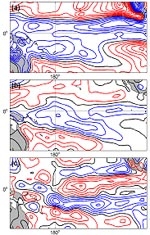Relative Influences of the Interdecadal Pacific Oscillation and ENSO on the South Pacific Convergence Zone
J.A. Renwick, M.J. Salinger, A.B. Mullan, C.K. Folland & A. Gosai


This summary is based on recent work done by NIWA and the U.K. Met Office Hadley Centre (Folland et al 2002). The South Pacific Convergence Zone (SPCZ) is one of the most significant features of subtropical Southern Hemisphere climate (Kiladis et al., 1989; Vincent, 1994). It is characterized by a band of low-level convergence, cloudiness and precipitation in the western Pacific extending south eastwards towards French Polynesia. Its location varies in relation to both the Interdecadal Pacific Oscillation (IPO) and El Niño Southern Oscillation (ENSO). The SPCZ is a broad feature, and is associated with maxima of sea surface temperatures (SST), precipitation, cloudiness, low level convergence and a of minima out-going long-wave radiation (OLR).
The SPCZ is linked to the Inter-Tropical Convergence Zone (ITCZ) in the west over the Pacific warm pool and it is maintained by the interaction of the trade winds and disturbances in the mid-latitude westerlies in the east. The SPCZ tends to be most active during the southern hemisphere summer months (November- April). Trenberth (1976) showed that location of the SPCZ varies systematically with ENSO-related expansion and contraction of the western Pacific warm pool, moving northeast during El Niño events and southwest during La Niña events. The SPCZ also changes its mean locations with the polarity of the IPO, a ~15-30 year time scale fluctuation in SST and circulation across the whole of Pacific basin (ICU 21 & 23, Power et al., 1999). Variations in the mean location of the SPCZ are important for South Pacific climate, as precipitation can vary strongly with the movement (Salinger et al., 1995).
Relations between the SPCZ, ENSO and the IPO were analysed using an SPCZ Position Index (SPI; Suva minus Apia pressure difference), the Southern Oscillation Index (SOI) and an IPO index calculated from the SST pattern in Fig 1. When the IPO is in its negative phase, and in a La Niña, the mean position of the SPCZ is displaced to the southwest. During the positive IPO, and in an El Niño, the SPCZ is displaced northeast.
Analysis of variance confirms that the SPI was significantly related both to the state of the IPO and SOI during 1891-2000.
Figure 2 shows changes in 10m divergence related to ENSO and the IPO. The top panel shows the mean pattern of Nov-Apr divergence during 1958-1998. The middle panel shows that El Niño events lead to a north-eastward movement of the SPCZ, relative to a cool La Niña event, and there is a tendency for blending of the ITCZ and the SPCZ in the central equatorial Pacific. The bottom panel shows analogous behaviour of the SPCZ in the warm phase of the IPO (1978-1998), resulting in a northward shift compared to the cool phase (1958-1977).
Therefore, it is demonstrated that both ENSO and the IPO influence the SPCZ quasi- independently. Spatial patterns of decadal trends in recent climate in the South Pacific are strongly affected by the SPCZ, especially the IPO-related changes in the mid 1970s (Folland et al., 1997; Salinger et al., 1995; Salinger et al 2001).
References
Folland, C.K.; Salinger, M.J.; Rayner, N. (1997). A comparison of annual South Pacific island and ocean surface temperatures. Weather and Climate 17(1): 23-42.
Folland, C.K.; Parker, D.E.; Colman, A.; Washington, R. (1999). Large scale modes of ocean surface temperature since the late nineteenth century. In: A. Navarra (ed.). Beyond El Nino: Decadal and Interdecadal Climate Variability, pp. 73-102. Springer-Verlag, Berlin.
Folland, C.K.; Renwick, J.A.; Salinger, M.J.; Mullan, A.B. (2002). Relative influences of the Interdecadal Pacific Oscillation and ENSO on the South Pacific Convergence Zone. Geophysical Research Letters 29(13): 10.1029/2001GL014201, 21-1-21-4.
Kiladis, G.N.; von Storch, H.; van Loon, H. (1989). Origin of the South Pacific convergence zone. Journal of Climate 2(10): 1185-1195.
Power, S.; Casey, T.; Folland, C.; Colman, A.; Mehta, V. (1999). Inter-decadal modulation of the impact of ENSO on Australia. Climate Dynamics 15(5): 319-324.
Salinger, M.J.; Basher, R.E.; Fitzharris, B.B.; Hay, J.E.; Jones, P.D.; Macveigh, J.P.; Schmidely-Leleu, I. (1995). Climate trends in the south-west Pacific. International Journal of Climatology 15(3): 285-302.
Salinger, M.J.; Renwick, J.A.; Mullan, A.B. (2001). Interdecadal Pacific Oscillation and South Pacific climate. International Journal of Climatology 21: 1705-1722.
Trenberth, K.E. (1976). Spatial and temporal variations of the Southern Oscillation. Quarterly Journal of the Royal Meteorological Society 102: 639-653.
Vincent, D.G. (1994). The South Pacific Convergence Zone (SPCZ): a review. Monthly Weather Review 122(9): 1949-1970.
